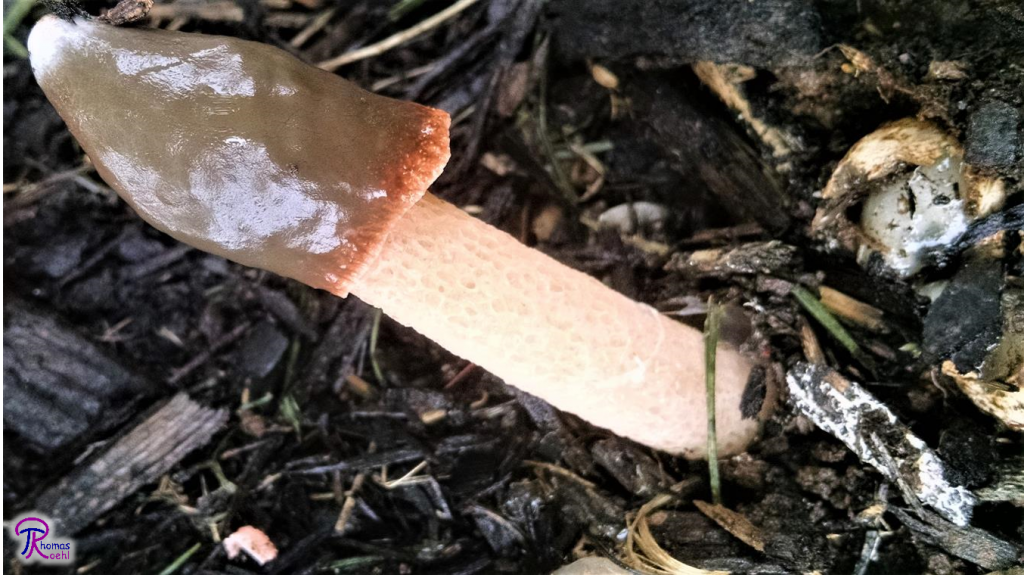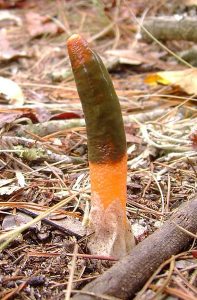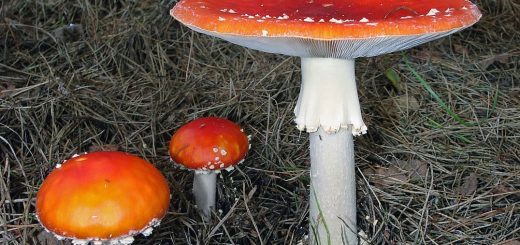#190: Common Mulch Stinkhorns

The stinkhorn Phallus rubicundus can be distinguished by the presence of a distinct head and by the large, sponge-like holes in its stipe. Note the eggs on the right-hand side of this picture.
Stinkhorns love humans. These mushrooms can eke out a living in natural habitats, but they really thrive in artificial ones like mulch beds. Unfortunately, humans don’t feel the same way about stinkhorns. We tend to find them offensive, thanks to their foul odors and phallic shapes. Perhaps no one disliked stinkhorns more than Etty Darwin (Charles Darwin’s granddaughter); legend has it that she would diligently remove stinkhorns from her property and burn them to discourage impure thoughts in her servants.1 Appropriately (or perhaps inappropriately), the most common mulch stinkhorns belong to two genera named for these mushrooms’ offensive shapes: Phallus and Mutinus.* Of those mushrooms, Phallus rubicundus and Mutinus elegans are the most frequently encountered in North American gardens.
Eggs (Button Stage)

One half of a stinkhorn egg. Stinkhorn eggs have a gelatinous outer layer, a crumbly spore-producing layer, and a tough central column.
Both of the common mulch stinkhorns, P. rubicundus and M. elegans produce mushrooms that sprout from underground structures known as ‘buttons’. Stinkhorn buttons usually resemble bird eggs, so the buttons are often called ‘eggs’ by mushroom hunters. The eggs are spherical to ovoid structures that are generally pale in color but may have shades of pink, purple, or brown. When sliced open, the eggs reveal a gelatinous layer surrounding a dark spore mass which mostly surrounds the center structure which looks like a shrunken version of a stinkhorn.2–6 This is the developmental stage that allows stinkhorns to fruit so quickly. Basically, the mushroom is already fully-formed inside the egg; all it has to do is expand (and fully expanded stinkhorns seem to be mostly air anyway). While in the egg stage, there are relatively few physical features visible, so it is difficult to identify the species with any degree of certainty. Once the conditions are right (usually soon after rain), the contents of the egg begin expanding rapidly and burst through the thin external layer.
Description: P. rubicundus
P. rubicundus is for the most part shaped like a long spike. It grows up to 20cm tall but only gets up to 1.5cm thick. The stipe can display various colors from the red, orange, and pink ranges and is usually more vibrant at the tip and paler at the base. If you pick up one of these mushrooms, they are remarkably lightweight; the stipe is hollow and its surface is riddled with long, sponge-like pits, so the mushroom has very little substance. Around the base of the stipe, the remains of the outer layer of the egg form a flimsy membranous cup called a ‘volva’.
The most important part of the mushroom for identification is the tip. P. rubicundus, like all other members of its genus, produces spore slime on a ‘head’ or ‘cap’ that drapes down from the tip of the stipe. The conical head reminds me somewhat of a tiny wizard’s cap sitting on top of an icicle. The spore-containing slime is dark greenish-brown and smells absolutely foul. Since the pungent spore slime coats the outer surface of the head, it never touches the stipe. Underneath the spore slime, the surface of the head is wrinkled.3,5,6 This is easiest to see after the flies have eaten the slime away. Some specimens of P. rubicundus have a skirt-like veil that drapes down below the head. This veil is composed of the same material as the stipe, so it can be hard to see when dried out.5

Mutinus elegans produces spore slime directly on the stipe. Its orangish colors and gracefully tapering stipe distinguish it from similar species. Photo by Erica Urbanovitch (Mushroom Observer) [CC BY-SA 3.0], via Wikimedia Commons
Description: M. elegans
M. elegans is very similar in appearance to P. rubicundus. Both mushrooms are about the same size, although M. elegans is slightly smaller: that mushroom grows only up to 17cm tall and 1.5cm wide. Another similarity is that M. elegans is also a spike-shaped mushroom with red, orange, and/or pink shades that pale toward the base. Additionally, the outer surface of the egg remains as a volva at the base of both mushrooms. However, the surface of the stipe is slightly different in M. elegans. That mushroom’s stipe is still hollow and sponge-like, but the holes on the surface are tiny and make the surface appear more bumpy than spongy. The most significant difference is in the spore slime. M. elegans does have a foul-smelling olive-brown spore slime, but it is borne directly on the top part of the stipe. It also tends to produce more spore slime; the slime routinely covers well over 3cm of the stipe.2,4
Ecology
Both mushrooms do exceptionally well in mulch, which they decompose. They are common sights popping up in mulch beds anywhere east of the Rocky Mountains from spring through late summer. Both mushrooms also live on other continents, but their true ranges are hard to pin down because of their preference for gardens.2–5
M. elegans is supposedly more abundant and has a broader range than P. rubicundus. Despite this, I don’t think I’ve ever seen M. elegans. Every time I inspect a group of stinkhorns growing in mulch, they turn out to have a head and are therefore P. rubicundus. However, Michael Kuo and Gary Emberger both note that the range of P. rubicundus seems to be expanding in the northern part of the United States, probably thanks to the commercial mulch industry. Kuo also suggests that many P. rubicundus specimens are misidentified as M. elegans, so P. rubicundus could be more common than mycologists realize.3,5
Why do these mushrooms do so well in mulch? In the wild, stinkhorns decompose wood in forest litter.4 Mulch provides the wood for food but also provides cover and protection like the leaves and other less woody components of forest litter. On top of that, humans have chopped up the wood into bite-sized pieces for the fungus. This increases the surface area available to the fungus, so nearly all of the nutrients in the mulch are available to the fungus from the outset.
Of course, the most fascinating part of the stinkhorn story is their relationship with insects. Bugs, especially flies, are attracted by the foul smells, walk around in the spores, and then carry the spores to new locations. To read more about the stinkhorn life cycle, see FFF#040.7
Edibility
“Can I eat that?” probably isn’t your first question after hearing about “foul-smelling spore slime,” but many stinkhorns actually are considered edible. M. elegans, for example, is edible while it is still in the button/egg stage. P. rubicundus is listed as “edibility unknown,” but many other species of Phallus produce edible eggs. At the very least, I don’t think P. rubicundus is considered poisonous.4–6
Similar Species
Pretty much every species of stinkhorn will grow in mulch. So, don’t be surprised if your mushroom doesn’t quite match the descriptions above. In addition to the species described below, some stinkhorns found in mulch have multiple stipes or bucky-ball-like features, but those belong to different genera and are easily distinguished.
P. rubicundus resembles ravenelii, P. impudicus and P. hadriani, but they are fairly easy to separate. None of the three look-alikes have orangish colors and they all tend to be stockier than P. rubicundus. There are a couple other species of Phallus that are common in North America, but these have distinctive, net-like skirts that hang down from the head.
M. elegans is very similar to M. caninus and M. ravenelii, but there are subtle differences. M. caninus swells slightly at the tip and the spore slime covers less of the stipe (only 2-3cm). M. ravenelii tends to have larger pits on the stipe, which is pinkish in color (instead of orangish to reddish).2
Getting Rid of Stinkhorns
The biggest problem with stinkhorns fruiting in mulch is that people usually don’t want them there. Given how much time and effort people spend cajoling their gardens into immaculate works of art, I suppose that is understandable. The simplest way to restore the artistic splendor is to follow Etty Darwin’s example and remove the mushrooms from the garden. Of course, this is a Sisyphean task since the fungus – which is still alive and growing in the mulch – will just produce more mushrooms the next time conditions are right.

Stinkhorns are notorious for appearing in gardens when they’re not wanted. Photo by John S. Harper (jsharper, Mushroom Observer) [CC BY-SA 3.0], via Wikimedia Commons
Thankfully, stinkhorns wilt just as fast as they fruit. Most stinkhorns collapse within a day and all evidence of the mushrooms can easily disappear within a week. So perhaps the easiest solution is to learn to live with the stinkhorns.
Taxonomy
Both Phallus and Mutinus fall under the family Phallaceae, which contains all the stinkhorns.7 There are a few morphological differences between the American and European M. elegans, so don’t be surprised if the American version gets a new species name in the future.2 Both P. rubicundus and M. elegans have common names, although I do not hear these very often. P. rubicundus is known as the “Devil’s Stinkhorn” while M. elegans is called the “Elegant Stinkhorn” or “Devil’s Dipstick.”4,5
* Apparently Mutinus is named after the Roman god Mutinus Titinus (also spelled Mutunus Tutunus), a marriage-related deity symbolized by the phallus.9,10
| Kingdom | Fungi | |
| Division | Basidiomycota | |
| Subdivision | Agaricomycotina | |
| Class | Agaricomycetes | |
| Subclass | Phallomycetidae | |
| Order | Phallales | |
| Family | Phallaceae | |
| Genus | Phallus | Mutinus |
| Species | Phallus rubicundus (Bosc) Fr.11 | Mutinus elegans (Mont.) E. Fisch12 |
This post does not contain enough information to positively identify any mushroom. When collecting for the table, always use a local field guide to identify your mushrooms down to species. If you need a quality, free field guide to North American mushrooms, I recommend Michael Kuo’s MushroomExpert.com. Remember: when in doubt, throw it out!
See Further:
http://www.mushroomexpert.com/phallus_rubicundus.html
http://www.messiah.edu/oakes//fungi_on_wood/stinkhorn/species%20pages/Phallus%20rubicundus.htm
http://www.first-nature.com/fungi/phallus-rubicundus.php
http://www.mushroomexpert.com/mutinus_elegans.html
http://www.messiah.edu/oakes/fungi_on_wood/stinkhorn/species%20pages/Mutinus%20elegans.htm
Citations
- Kuo, M. Phallus impudicus & Phallus hadriani: The Common Stinkhorn. MushroomExpert.Com (2006). Available at: http://www.mushroomexpert.com/phallus_impudicus.html. (Accessed: 9th June 2017)
- Kuo, M. Mutinus elegans, M. caninus, & M. ravenelii. MushroomExpert.Com (2006). Available at: http://www.mushroomexpert.com/mutinus_elegans.html. (Accessed: 9th June 2017)
- Kuo, M. Phallus rubicundus. MushroomExpert.Com (2011). Available at: http://www.mushroomexpert.com/phallus_rubicundus.html. (Accessed: 9th June 2017)
- Emberger, G. Mutinus elegans. Fungi Growing on Wood (2008). Available at: http://www.messiah.edu/oakes/fungi_on_wood/stinkhorn/species%20pages/Mutinus%20elegans.htm. (Accessed: 9th June 2017)
- Emberger, G. Phallus rubicundus. Fungi Growing on Wood (2008). Available at: http://www.messiah.edu/oakes//fungi_on_wood/stinkhorn/species%20pages/Phallus%20rubicundus.htm. (Accessed: 9th June 2017)
- O’Reilly, P. Phallus rubicundus (Bosc) Fr. First Nature Available at: http://www.first-nature.com/fungi/phallus-rubicundus.php. (Accessed: 9th June 2017)
- Kuo, M. Stinkhorns: The Phallaceae and Clathraceae. MushroomExpert.Com (2011). Available at: http://www.mushroomexpert.com/phallaceae.html. (Accessed: 9th June 2017)
- Volk, T. J. Mushrooms, fungi and slime molds that grow in mulch or potted plants. Tom Volk’s Fungi (2004). Available at: http://botit.botany.wisc.edu/toms_fungi/mulch.html. (Accessed: 9th June 2017)
- Mutinus. Wikipedia (2017).
- Mutunus Tutunus. Wikipedia (2016).
- Phallus rubicundus. Mycobank Available at: http://www.mycobank.org/Biolomics.aspx?Table=Mycobank&Rec=244095&Fields=All. (Accessed: 9th June 2017)
- Mutinus elegans. Mycobank Available at: http://www.mycobank.org/name/Mutinus%20elegans&Lang=Eng. (Accessed: 9th June 2017)


![#124: Galerina marginata, the Deadly Galerina [Archived]](https://www.fungusfactfriday.com/wp-content/themes/hueman/assets/front/img/thumb-medium-empty.png)





![#011: Characteristics of Kingdom Fungi [Archived]](https://www.fungusfactfriday.com/wp-content/themes/hueman/assets/front/img/thumb-small-empty.png)



Mutinus elegans and Mutinus caninus are very similar species. I took this photo in N. Illinois in September:
http://www.imagereserve.com/photo/20180922145239
I identified it as elegans, but I’m not 100% sure. What do you think it is?
I’d tentatively go with M. elegans. The tip doesn’t seem to be noticably swollen (although that’s easier to assess after flies have eaten away the slime).
This article is the only source I could find that compares M. elegans and M. caninus directly and explains differences between the two (Besides Wikipedia, which didn’t help much). I will attribute the photo as M. elegans. Thank you very much.